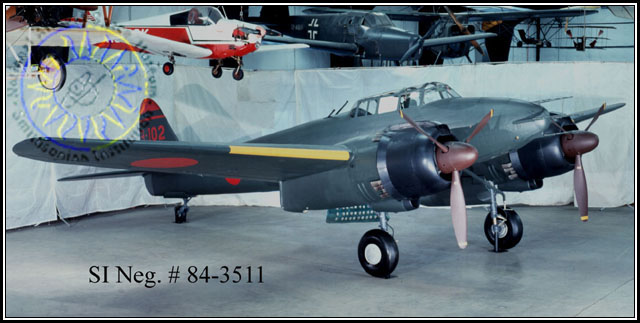 Nakajima J1N1-S Gekko
Nakajima J1N1-S Gekko Nakajima J1N1-S Gekko
Nakajima J1N1-S GekkoFrom Smithsonian National Air and Space Museum Nakajima J1N1-S Gekko Page
Nakajima Hikoki K. K. J1N1-S Gekkos were the first Japanese aircraft designed and built specifically to intercept and destroy other aircraft at night and in poor weather. Gekkos achieved some notable successes during three years of service with the Japanese Navy.
This design took shape in 1938 not as a night interceptor, but as a long-range fighter that could protect bombers. The Nakajima design, called the J1N1 and crafted by engineer Katsuji Nakamura, most readily met the navy's requirements and a prototype was flight-tested in May 1941. In the two years since the navy's original demand, Mitsubishi had developed and placed into service the Zero fighter (also in the NASM collection) and this superlative airplane had solved the bomber escort problem. Nakajima nonetheless forged ahead and flew a J1N1 prototype May 2. A year-and-a-half of flight tests proved beyond doubt that this aircraft was inferior to single-engine fighters. Except for range and takeoff distance, the type failed to meet any requirements in the 1938 specifications.
The Japanese Navy took an interim step, however, before testing the J1N1 in night operations. The navy authorized Nakajima engineers to convert the design into a high-speed, long-range, naval reconnaissance aircraft based on land. Sweeping changes to the airframe, engines, and armament made the aircraft more reliable and suitable for the new mission. Between April 1942 and March 1943, Nakajima delivered just fifty-four of the new model, the J1N1-C, including four prototypes. U. S. forces first encountered the aircraft during early operations in the Solomon Islands and codenamed it the IRVING. The J1N1-Cs served in limited numbers and flew primarily from the great Japanese base at Rabaul on New Britain. The base was a regular target for night-flying U. S. Army Air Forces Boeing B-17 Flying Fortresses. Sometime in the spring of 1943, Commander Yasuna Kozono ordered a J1N1-C modified for night interceptor work. Maintenance crews cleaned out the observer's position behind the pilot and mounted two 20 mm cannon fixed to fire above and to the front of the new night fighter at a 30-degree angle. Two more cannons were mounted in similar fashion but fired downward. The experimental airplane was designated the J1N1-C KAI.
On the night of May 21, the modified IRVING intercepted and shot down a pair to B-17 bombers. This immediate success caught the attention of the Naval Staff and they ordered Nakajima to begin full-scale production. The new interceptor was named the J1N1-S Gekko (Moonlight). At this time, no one in Allied intelligence circles expected the Japanese to field an effective night fighter and months passed before anyone discovered what lay behind a string of regular and mysterious losses of both B-17s and Consolidated B-24 Liberator bombers. Nakajima concentrated on producing the Gekko version of the J1N for the remainder of the war.
Part of the "secret" of building in X-Plane is preparation, and I have learned a lot from my previous efforts. I photocopied the three-view drawings from the book and drew and measured all the pertinent dimensions before starting in Planemaker. The Gekko is a fairly conventional twin engined fighter of the WW2 era, so there were few problems adapting it to X-Plane. For this aircraft I decided to use the "float/tank" shape in Planemaker to form the cockpit area, which is a real timesaver and looks better, too. One other unusual item is the flap design. The Gekko is fitted with Fowler flaps, with a setting of 25 degrees for takeoff and combat and 35 degrees for landing. The wing dihedral of seven degrees is per drawing, making for a very stable flight.
As is usual for aircraft from the Temple Air stable, the panel is stock, as are the sounds. I am pleased with how the paint job turned out. As you can see from the photo at the bottom of this page the Gekko has an unusual color for the props and spinners, which I tried to match with mixed results. The rest of the aircraft came out pretty well.
On a more personal note, I have to say that after spending hours struggling with the Cutlass and the Ascender in flight test, I was unprepared for the ease with which the Gekko flew on it's first flight. This was not due to any brilliant design on my part, rather it speaks well of the original Nakajima design, and the ability of X-Plane to accurately model the physics of a real world aircraft.
Download the Nakajima J1N1-S Gekko version 1.0 (X-Plane version 5.62)


| Email James Z Temple | Return to Home Page |